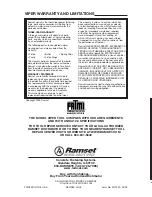
4. Lower the tool, keeping it pointed in
a safe direction, and insert the next
fastener or fastener assembly.
Note:
While the Viper tool is being closed and
fired, the advance lever cam has caused
the load advance lever to be indexed
downward to pick up the next load.
When the tool is lowered and opens
up, the next unfired load is indexed
upward to the firing position. At the
same time, as the tool is lowered, the
piston is automatically reset for the
next fastening.
NEVER PLACE YOUR HAND OR
FINGERS OVER THE MUZZLE
BUSING WHILE AN UNFIRED LOAD
IS IN POSITION TO BE FIRED.
5. After all 10 loads in the strip have been
fired, pull the used load strip from the
top of the tool. NEVER try to pull a load
strip from the bottom of the tool.
6. If you are working in an area where
dirt or debris can fall onto the tool
while making fastenings, check the
tool frequently to be sure the muzzle
bushing and loads strip track are clear.
NOTE: Use of partially used load strips.
The design of the Viper tool is such that
the next load to be fired is automatically
indexed into the firing position during
the tool closing, firing and tool opening
sequence of operation. If it is necessary
to use a partially used load strip, the
end of the strip containing the live loads
should be placed into the bottom of the
tool handle just as if it were a new strip.
By counting the number of unfired loads
in the strip before inserting it and keeping
count as the fastenings are being made,
one can easily determine when all of the
loads have been used.
SHOULD YOU DECIDE NOT TO MAKE A
FASTENING AFTER THE TOOL HAS BEEN
LOADED, ALWAYS REMOVE THE POWDER
LOAD FIRST, THEN THE FASTENER. THIS
WILL PREVENT ACCIDENTAL DISCHARGING
OF THE FASTENER OR PISTON INTO THE
OPERATORS HAND.
TOOL OPERATING INSTRUCTIONS
TOOL OPERATING INSTRUCTIONS
10
INSERT THE NEXT FASTENER OR
FASTENER ASSEMBLY INTO THE
MUZZLE BUSHING
REMOVE THE LOAD STRIP FROM THE TOP
OF THE TOOL
CHECK THE MUZZLE BUSHING AND
LOAD STRIP TRACK FOR DEBRIS
4. Baje la herramienta, manteniéndola
apuntando en una dirección segura, e
inserte el siguientre elemento de fijación
o conjunto de elementos de fijación.
Nota:
aunque la herramienta Viper está
cerrándose y disparándose, la palanca
de avance de la leva ha ocasionado que
la palanca de avance de la carge avance
hacia abajo para tomar la siguiente carga.
Cuando la herramienta se baja y se abre,
la siguiente carga sin disparar avanza
hacia arriba a la posición de disparo.
Al mismo tiempo que la herramienta se
baja, el pistón es colocado automática-
mente para la siguiente fijación.
NUNCA COLOQUE LA MANO O
LOS DEDOS SOBRE LA BOQUILLA
CUANDO UNA CARGA ACTIVA ESTÉ
EN POSICIÓN PARA EL DISPARO.
5. Después que se hayan disparado
las 10 cargas en una tira de cargas,
saque ésta por la parte de arriba de la
herramienta. NUNCA intente sacar una
tira de cargas por la parte de debajo de
la herramienta.
6. Si se encuentra trabajando en una
zona donde polvo o desechos puedan
caer sobre la herramienta mientras
está realizando fijaciones, revise
frecuentemente la herramienta para
aseguarse de que tanto la boquilla
como la tira de cargas están limplas.
NOTA: empleo de tiras de carga
utilizades en parte.
El diseño de la herramienta Viper hace
posible que la siguiente carga a disparar
avance automáticamente a la posición
de disparo durante la secuencia de
operación de cierre, disparo y apertura
de la herramienta. Si es necesario emplear
una tira de cargas utilizada en parte, el
extremo de la tira conteniendo las cargas
vivas debe colocarse dentro del fondo
de la empuñadura de la herramienta tal y
como si fuera una nueva tira. Si se cuenta
el número de cargas sin disparar en la tira
antes de insertarla y manteniendo la cuenta
a medida que se efectúan las fijaciones,
uno puede fácilmente determinar cuando
se han utilizado todas las cargas.
SI DECIDE NO HACER UNA
FIJACIÓN DESPUÉS DE CARGAR LA
HERRAMIENTA, RETIRE SIEMPRE
LA CARGA DE PÓLVORA PRIMERO Y
LUEGO EL ELEMENTO DE FIJACIÓN.
ESTO IMPEDIRÁ UNA DESCARGA
ACCIDENTAL DEL ELEMENTO DE
FIJACIÓN O EL PISTÓN EN LAS
MANOS DEL USUARIO.
INSTRUCCIONES DE OPERACIÓN
DE LA HERRAMIENTA
INSTRUCCIONES DE OPERACIÓN
10 DE LA HERRAMIENTA
INTRODUZCA EL SIGUIENTE ELEMENTO
DE FIJACIÓN O CONJUNTO DE
ELEMENTOS DE FIJACIÓN DENTRO
DEL MANGUITO EN LA BOCA
SAQUE LA TIRA DE CARGAS POR LA
PARTE DE ARRIBA DE LA HERRAMIENTA
REVISE EL MANGUITO EN LA BOCA
Y LA TIRA DE CARGAS PARA VER
SI TIENEN BASURA


































